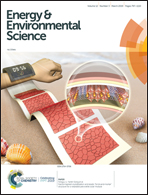Techno-economic analysis and life-cycle greenhouse gas mitigation cost of five routes to bio-jet fuel blendstocks†
Abstract
Decarbonizing the air transportation sector remains one of the most challenging hurdles to mitigating climate change. Lignocellulosic biomass-derived jet fuel blendstocks can contribute to the shift toward renewable, low-carbon energy sources for aircrafts. Producing these renewable jet fuel molecules from biomass requires advanced pathways with the potential for efficient and affordable conversion routes. This paper presents a detailed techno-economic analysis and sensitivity analysis, including estimated minimum selling price (MSP), and life-cycle greenhouse gas (GHG) mitigation costs for five routes to four potential bio-jet fuel molecules – limonane via limonene, limonane via 1,8-cineole, tetrahydromethylcyclopentadiene dimer (RJ-4), bisabolane, and epi-isozizaane. The simulated biorefineries utilize biomass sorghum and an integrated high-gravity ionic liquid-based biomass deconstruction process. We present results reflecting the current state of the technology and potential future scenarios with improved yields. Among the conversion pathways and the fuel molecules evaluated in this study, limonane, bisabolane, and epi-isozizaane could reach an MSP of $0.73–$0.91 per L-Jet A ($2.75–$3.45 per gal-Jet A) in optimized future cases, without a hypothetical lignin-derived co-product. RJ-4 requires a more costly upgrading process and catalysts, resulting in a comparatively higher MSP ($1.33 per L-Jet A or $5.04 per gal-jet A). Based on the GHG footprints of each fuel, the minimum achievable carbon mitigation cost relative to conventional Jet-A is $29 per metric ton CO2e, which is just under double the current cap-and-trade market price in California. In the absence of any policy support, the economics could be improved through high-value uses for lignin. To reach a target selling price of $0.66 per L-Jet A ($2.50 per gal), lignin-derived products would need to be sold for at least $1.9 per kg. However, the higher energy density of these bio-based blendstocks offers valuable improvements in aircraft efficiency/range; we find that commercial airlines may be willing to pay a 4–14 cent per L premium for these bio-jet fuels. Our results highlight the need for improvements beyond currently-reported yields for the biologically produced intermediates, identification of ideal microbial hosts, selection of metabolic pathways to achieve competitive production costs, and a focus on fuels with attractive properties that increase their value.



 Please wait while we load your content...
Please wait while we load your content...